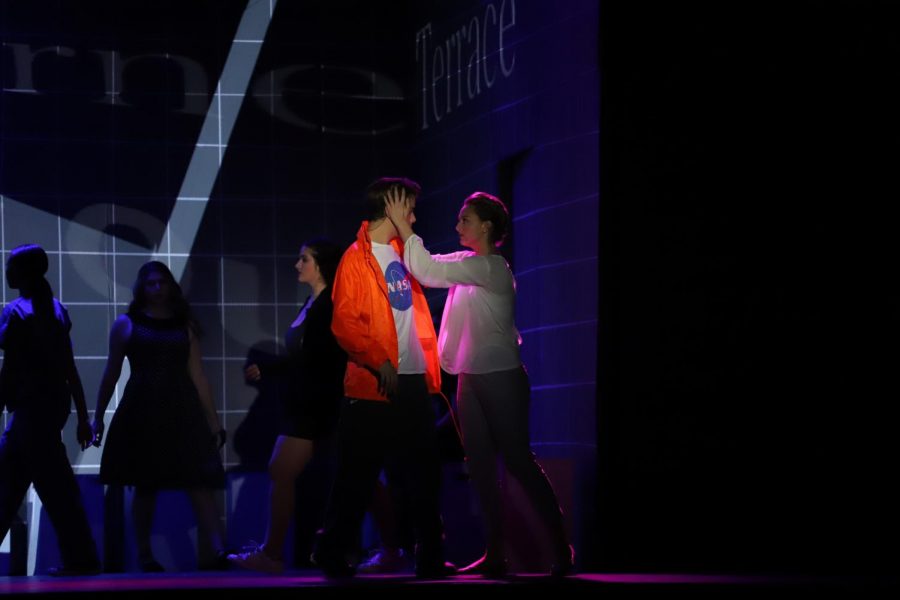The Curious Incident of Autism in the Arts
January 29, 2020
Uh Oh.
This was my initial reaction upon hearing the news that Pali’s next play would be an adaptation of Mark Haddon’s 2003 novel, “The Curious Incident of the Dog in the Night-Time.”
This story paints a picture of Christopher Boone, a 15-year-old boy implied to be on the autism spectrum, who must navigate an earth-shattering discovery about his family. When I read the book, I found it to be a sympathetic and touching portrait of a teen, who, like anybody else, is trying to make sense of the world around him. Within it, Christopher’s vast pool of emotions are shown through the unconventional way he processes his surroundings; his black-and-white view of the world places his moral clarity and pure intentions on full display.
When I realized that putting on a Pali production of this story would entail casting an actor not on the spectrum, I admit, my skin crawled. To have a high-schooler fake a disability for dramatic purposes just did not seem right.
Autism is a wide spectrum of conditions ranging anywhere from non-verbal to high-functioning behavior. The personal struggle that comes with being on the spectrum can be difficult for anyone else to understand; when actors try to mimic autistic traits, they run the risk of misrepresenting an already marginalized community. In my head, it is almost akin to a white actor pretending to be a black character — it’s just not a good idea.
On a Friday night, I sat down to watch Pali’s play and to decide for myself whether or not my concerns were justified. After the lights dimmed, Jack Essner, the actor who played Christopher, did exactly what I anticipated. He rocked, blinked, interrupted others, hit himself, hit others and moaned all throughout the play. But, miraculously, his actions did not come off as outlandish or weird, as I had feared. Instead, Essner was able to convey a character simply trying to find his place in a world, which, at times, did not try to understand, much less care for him.
Moreover, Essner expertly accomplished the primary objective of the play, enabling the audience to enter the mind of his unique character. Indeed, the staging of it was designed to accomplish this feat. Three unadorned grey walls served as the only scenery, representing the landscape of Christopher’s mind. Essner acted as a guide throughout this space, making the events of his hectic life understandable through his character’s perceptions. His immersive performance enabled us to feel every twisting emotion of the story and forget that this was Jack-from-sixth-period playing an autistic character.
After the play ended and the last of the confetti fell, I wondered how Essner could have accomplished this transformation. In a later interview, he explained that crafting his character “took hours of research and meetings with the on-campus therapists and psychologists,” as well as in-person meetings with people on the spectrum “who gave [him] advice for an accurate portrayal.”
Essner and the rest of the cast demonstrated that a respectful and well-researched approach was the key to their sensitive portrayal. By interacting with individuals from this community, they avoided the disastrous mistake of constructing a reality founded on biases and stereotypes.
Despite my relief at the cast and crew’s delicate handling of the material, some of my initial concerns still warrant wider discussion. When is it OK for this minority group to be represented by a person outside of it? Where is the line?
The answer, it seems to me, is not clear-cut. Here, we find a community of people who are largely pushed into the margins of society, not only in entertainment but in everyday life. They have only just begun to have a voice within it; but even this is not altogether theirs. The stories of these individuals are consistently told through the interpretations of actors who don’t share their realities. This kind of representation hovers in social limbo — just between the realms of inspirational evocation and uncomfortable impersonation.
Pretending to have a disability is known to actors as “cripping up,” and it is nothing new. For autism, it began with the 1988 film “Rain Man.” Dustin Hoffman portrayed Raymond Babbitt, a man with savant syndrome (a kind of autism that additionally gives the person extreme intellectual gifts). Hoffman’s remarkable transformation highlighted his character’s extraordinary mental capacity and internal humanity. As a result of his performance, new roles portraying people on the autistic spectrum became somewhat of a vague trend in art, culminating today in shows such as “The Good Doctor.” The challenges of these roles have also been a large draw for actors like Leonardo DiCaprio, who played Arnie, a bubbly autistic teenager in the 1993 film “What’s Eating Gilbert Grape.” As DiCaprio put it, “These characters don’t come along very often. I knew Arnie was one of those that I just had to do.”
Most of these depictions by non-autistic actors evolved past the impossibly dated trope of “crazies” in white-walled institutions far from society, with many designed to create some degree of connection with these oft-misunderstood characters. What’s come from this media representation is an outpouring of funding for autism-related organizations. Pali’s production continues the tradition of shedding light on this community.
Even so, the few roles that exist often perpetuate the “walking calculator” stereotype (“The Curious Incident” is actually an example of this). The downside of such representation, however awe-inspiring, is that it sets impossible standards for autistic individuals. Only a small fraction of those in the autistic community has these gifts, leaving the rest feeling an overwhelming pressure to perform at this level.
Given this slurry of pros and cons, the prospect of non-autistic actors playing those on the spectrum remains controversial. As a whole, the increasing frequency of this phenomenon highlights the sad fact that people with autism don’t have a large voice in the entertainment industry and can’t always choose how they are depicted. But, as we have seen from the Pali play and other such productions, positive representations can be catalysts for change.
The ultimate hope is that portrayals of autism by autistic actors will become commonplace. As it happens, even other adaptations of “The Curious Incident” have taken this plunge. In the Florida Studio Theatre’s production of the play, neurodivergent actor Alexander Stuart portrayed Christopher. He followed in the footsteps of Mickey Rowe, the first actor with autism to play the role in America. Rowe went on to form the National Disability Theatre, an organization which employs only disabled actors to tell compelling stories like Christopher’s. Such honest portrayals hold their own distinct set of challenges, but the priceless reward is authenticity. Few though they are, these portrayals have had an indelible impact on the arts and are trailblazers for the autistic community. People with autism deserve a voice of their own in the arts, and perhaps one day they will get it.












